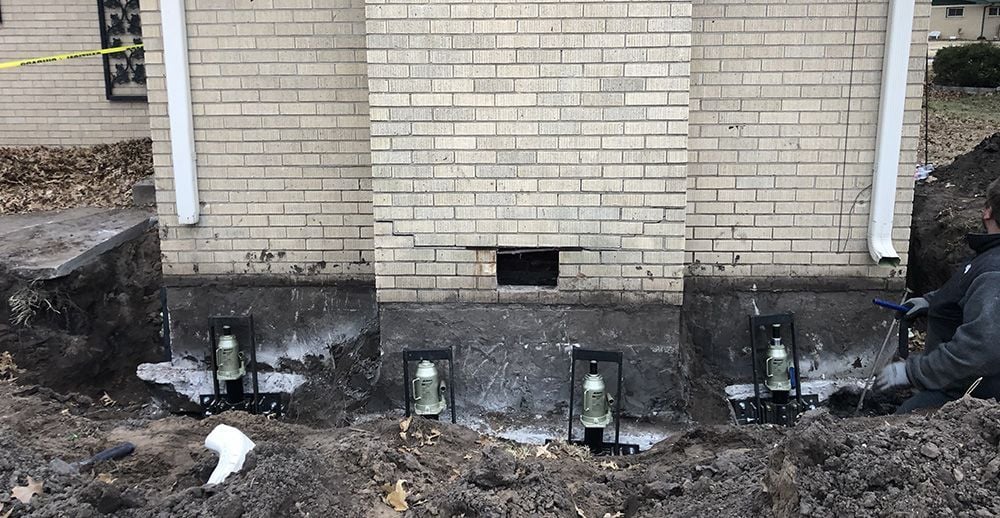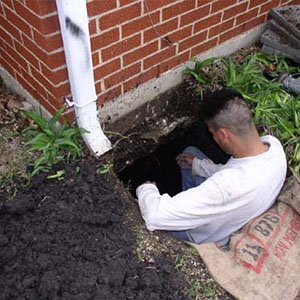Navigating Your Options for Foundation Repair Oklahoma City: A Homeowner's Manual
Navigating Your Options for Foundation Repair Oklahoma City: A Homeowner's Manual
Blog Article
Checking Out Different Methods of Structure Repair Service for Various Soil Kinds
Foundation repair work is a crucial facet of keeping structural stability, specifically when considering the varied challenges postured by various soil types. The complexity of soil behavior under differing problems requires a tailored method to repair, making sure ideal solutions such as helical piers for unpredictable soils or chemical cements for cohesive layers. The concern remains: how do we establish the most effective method for each unique scenario? Comprehending the interaction between soil features and repair service methods is important, yet there is more to discover in the mission for lasting services. What factors genuinely dictate the choice of approach?
Comprehending Soil Kinds
Soil types play an essential function in the security and durability of building foundations, making it important for home owners and building and construction professionals to comprehend their attributes and habits. The communication in between dirt and foundation can figure out the architectural integrity of a structure. There are a number of soil kinds, each with distinct physical buildings that affect how foundations are developed and kept.
Granular dirts, such as sand and crushed rock, offer good water drainage and are commonly considered stable. They have high load-bearing capabilities, which can support much heavier frameworks. Nevertheless, these soils can shift otherwise compacted properly, bring about potential negotiation problems. On the other hand, cohesive dirts like silts and clays show different behaviors. These soils tend to preserve wetness, and their load-bearing ability can vary substantially with modifications in dampness content.
Rocky soils, recognized for their toughness and stability, deal outstanding assistance for foundations however might need specific devices for excavation. On the other hand, loamy dirts, which are a well balanced blend of sand, clay, and silt, usually provide positive problems for structure assistance due to their moderate water drainage homes.

Comprehending these soil kinds is essential for selecting proper structure repair work methods, guaranteeing the resilience and security of structures over time.
Obstacles With Large Clay
Among the numerous soil types, large clay provides one-of-a-kind difficulties for structure security as a result of its propensity to undertake significant quantity adjustments with moisture variant. This kind of dirt swells when damp and contracts when dry, which can exert substantial pressure on frameworks. These fluctuations can bring about structure breaking, heaving, and settlement problems, posturing significant risks to the architectural stability of structures.
The difficulties with extensive clay are exacerbated by its plasticity index, which determines the soil's ability to change shape and volume. A high plasticity index suggests better possibility for motion, boosting the likelihood of damage to structures. This is especially troublesome in regions experiencing extreme or regular weather modifications, where cycles of wet and dry problems prevail.
Moreover, the deepness of large clay layers can vary, making complex the evaluation and preparation of suitable foundation repair work approaches. The unforeseeable nature of its motion requires specialized design remedies to minimize dangers. Furthermore, expansive clay can influence energy walkways, lines, and driveways, even more complicating repair service efforts. These complexities require a complete geotechnical evaluation to make sure effective foundation repair service techniques are applied, emphasizing the relevance of attending to large clay challenges with proficiency and care.
Solutions for Sandy Soils
Sandy soils, identified by their large particle size and low communication, existing unique difficulties for structure stability due to their propensity for shifting and erosion. By securing the structure to deeper, extra secure soil layers, these systems can supply the necessary assistance to neutralize the changing nature of sandy soils.
An additional advised technique is the application of soil stablizing approaches. Chemical grouting, as an example, includes injecting a stabilizing agent right into the dirt, which boosts cohesion and reduces leaks in the structure. This procedure assists to solidify the sandy substratum, thus reducing the risk of erosion and activity.
Additionally, mounting appropriate drain systems is essential in sandy soil problems. Ensuring adequate water drainage can avoid water accumulation around the structure, which commonly worsens erosion and dirt variation. Techniques such as French drains or my link surface grading can be employed to guide water far from the structure perimeter.
Attending To Working Out in Loamy Soils
Loamy soils, understood for their well balanced mix of sand, clay, and silt, provide an abundant base for lots of frameworks but can often result in structure settling as a result of their one-of-a-kind make-up. This balanced texture provides exceptional drain and nutrient retention, making it optimal for agriculture and landscaping. This very same feature can come to be bothersome for structures, as changes in wetness web content can cause the soil to increase or contract, leading to resolving.
Exact dirt screening is essential to establish the specific structure and moisture material of the loam. Once information is gathered, applying proper drainage solutions is necessary to keep consistent moisture levels, thereby minimizing the threat of soil tightening or development.

Innovative Repair Service Techniques
In the world of foundation repair work, cutting-edge strategies are continually being established to attend to the complex challenges positioned by various soil conditions. As soil kinds vary dramatically in their architectural buildings, typical techniques might not always suffice. The arrival of new modern technologies in structure repair work provides a lot more tailored remedies, making certain security and longevity.
One significant development is using helical piers, which are particularly effective in unstable or large dirts (foundation repair okc). These piers are screwed right into the ground till they get to a steady layer of soil, using solid assistance for the foundation above. This technique decreases disruption and is versatile to various dirt kinds, making it a functional service
Another cutting-edge technique is the application of polyurethane foam shot. This technique includes injecting high-density polyurethane foam beneath the structure to fill spaces and support the framework. It is a less intrusive alternative to conventional foundation, using fast installation with minimal disturbance to the surrounding location.
Additionally, soil stablizing methods, such as using chemical cements, have actually acquired grip. These compounds boost soil toughness and minimize leaks in the structure, protecting against future moving. Collectively, these innovative repair work techniques give reliable remedies for the diverse obstacles positioned by varying dirt problems.
Verdict

Foundation repair is a critical facet of preserving structural integrity, especially when taking into consideration the diverse challenges postured by different dirt types (foundation repair okc). address The complexity of dirt habits under varying conditions requires a customized method to fix, guaranteeing optimal options such as helical piers for unsteady dirts or chemical grouts for cohesive layers. By securing the foundation to much deeper, more stable soil layers, these systems can provide the required assistance to counteract the moving nature of sandy soils
Foundation repair work requires mindful consideration of soil types to ensure security and longevity. Chemical grouts boost dirt toughness and reduce permeability in cohesive soils.
Report this page